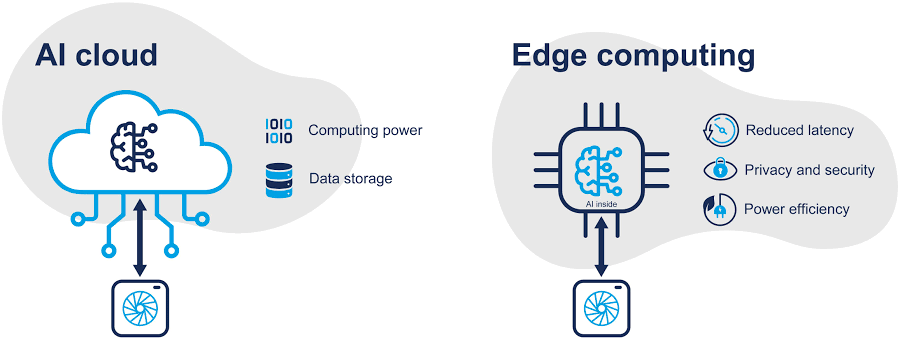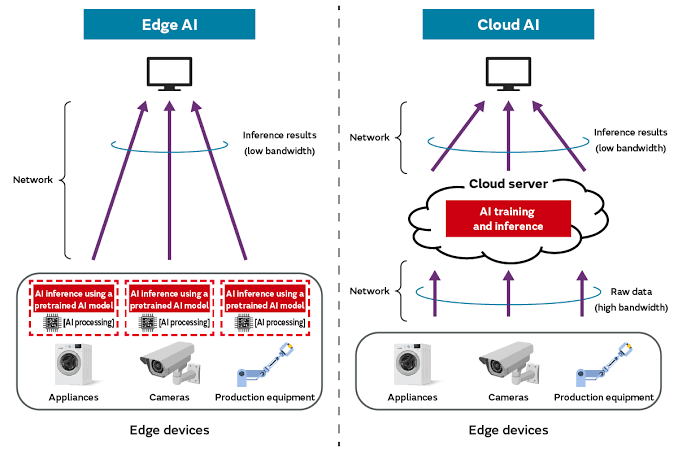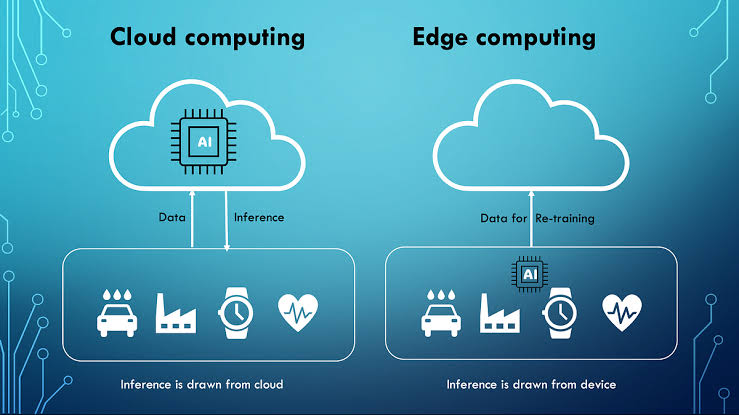The way data is processed is undergoing a significant transformation with the advent of Edge AI and on-device intelligence. Devices such as smartphones, wearables, and industrial sensors are now equipped with AI algorithms that enable them to process data locally, resulting in faster responses and improved privacy.
This shift towards localized data processing is made possible by combining artificial intelligence with edge computing, allowing data to be analyzed in real-time without relying on centralized servers.

The outcome is a more efficient, reliable, and cost-effective data processing mechanism that is revolutionizing various industries.
Key Takeaways
- Faster data processing with localized AI algorithms
- Enhanced privacy and security through reduced data transmission
- Improved reliability due to reduced dependence on centralized servers
- Increased efficiency in data processing
- Cost savings through reduced bandwidth usage




The Paradigm Shift: From Cloud to Edge Computing
The rise of edge computing marks a significant shift from the traditional cloud-centric approach to data processing. As the number of IoT devices grows, the need for real-time data processing is becoming increasingly important.
Traditional Cloud-Based AI Processing
Cloud computing has been the cornerstone of modern data processing, offering scalability and flexibility. However, it has its limitations.
Limitations of Centralized Processing
Centralized processing can lead to bottlenecks and delays in data transmission, affecting real-time applications. The reliance on cloud infrastructure can result in higher latency.
Bandwidth and Latency Challenges
The increasing volume of data generated by IoT devices strains bandwidth, causing congestion and latency issues. This can be particularly problematic for applications requiring real-time processing.
The Emergence of Edge Computing
Edge computing addresses these challenges by processing data closer to its source, reducing latency and improving real-time processing capabilities.
Decentralized Intelligence Architecture
A decentralized architecture allows data to be processed at the edge, reducing reliance on centralized cloud infrastructure. This approach enables faster decision-making and improved responsiveness.
The Hybrid Edge-Cloud Approach
A hybrid edge-cloud approach combines the benefits of both edge and cloud computing, offering a balanced solution for data processing. This approach enables organizations to leverage the strengths of both paradigms.
Edge AI & On-Device Intelligence: Core Concepts
As we dive into the world of Edge AI and on-device intelligence, we uncover the core concepts that are revolutionizing real-time data processing. This section will explore the fundamental principles behind Edge AI technology and on-device intelligence, providing a comprehensive understanding of their technical architecture.
Defining Edge AI Technology
Edge AI technology refers to the deployment of AI models and algorithms on edge devices, enabling them to process data locally. This approach eliminates the need for constant communication with the cloud or central servers, resulting in faster processing and reduced latency. Edge AI technology is particularly useful in applications where real-time processing is critical.
How On-Device Intelligence Functions
On-device intelligence functions by integrating AI models into edge devices, allowing them to make decisions based on local data. This integration enables devices to operate autonomously, making decisions in real-time without relying on cloud connectivity. On-device intelligence enhances the overall performance of devices by reducing reliance on external processing.
Technical Architecture of Edge AI Systems
The technical architecture of Edge AI systems is centered around the integration of AI models into edge devices. This architecture involves several key components, including model compression techniques and inference optimization.
Model Compression Techniques
Model compression techniques are used to reduce the size of AI models, making them more suitable for deployment on edge devices with limited computational resources. Techniques such as pruning, quantization, and knowledge distillation are commonly used to compress models.
Inference Optimization

Inference optimization is crucial for ensuring that AI models operate efficiently on edge devices. This involves optimizing the model’s inference process to minimize computational requirements and maximize performance. Techniques such as model optimization and hardware acceleration are used to achieve this goal.
Key Benefits of Processing Data at the Edge
With the rise of edge computing, organizations can now process data in real-time, reducing latency and improving overall performance. This shift towards edge AI is driven by the need for faster data processing, enhanced security, and more efficient data management.
Reduced Latency and Real-Time Responses
Edge AI enables real-time data processing, which is critical for applications that require immediate responses, such as autonomous vehicles and industrial automation. By processing data closer to the source, edge AI reduces the time it takes for data to travel back and forth, resulting in significantly reduced latency. This is particularly important for applications where milliseconds matter.
Enhanced Data Privacy and Security
Processing data at the edge also enhances data privacy and security. By keeping sensitive information on the device or at the edge, organizations can reduce the risk of data breaches and cyber attacks. This is especially important for industries that handle sensitive information, such as healthcare and finance.
Bandwidth Optimization and Cost Reduction
Edge AI helps optimize bandwidth usage by reducing the amount of data that needs to be transmitted to the cloud or central servers. This not only reduces the strain on network resources but also leads to significant cost savings on data transmission and storage.
Improved Reliability in Limited Connectivity
Edge AI also improves the reliability of applications in areas with limited or no connectivity. By processing data locally, edge AI enables devices to function independently, even when network connectivity is poor or unavailable. This is particularly useful for applications in remote or rural areas.
Hardware Enabling the Edge AI Revolution
As Edge AI continues to revolutionize data processing, the hardware behind this revolution plays a crucial role. The development of specialized hardware components has been pivotal in enabling Edge AI to process data locally, reducing latency, and enhancing overall system performance.
Specialized AI Chips and Neural Processing Units
Specialized AI chips and neural processing units (NPUs) are at the heart of Edge AI hardware. These chips are designed to handle AI and machine learning workloads efficiently, providing the necessary computational power for real-time data processing.
Mobile AI Accelerators
Mobile AI accelerators are a type of specialized chip designed to accelerate AI tasks on mobile devices. They enhance the performance of AI models, enabling faster and more efficient processing of data.
TinyML and Ultra-Low-Power Computing
TinyML is an emerging field that focuses on bringing machine learning to tiny devices, such as microcontrollers. Ultra-low-power computing is crucial for TinyML, as it enables devices to run AI models while consuming minimal power.
Energy-Efficient Computing for Battery-Powered Devices
Energy efficiency is critical for battery-powered devices that utilize Edge AI. Advanced hardware, such as energy-efficient processors and optimized memory, help minimize power consumption, ensuring that devices can operate for extended periods without recharging.
Some key features of energy-efficient computing include:
| Feature | Description | Benefits |
|---|---|---|
| Low-power processors | Processors designed to consume minimal power | Extended battery life |
| Optimized memory | Memory optimized for low power consumption | Reduced power usage |
| Power gating | Technique to reduce power consumption by gating power to unused components | Reduced power consumption |
Edge AI in Consumer Electronics
Edge AI is bringing about a new era in consumer electronics, making devices more intelligent and responsive. This integration is enhancing user experiences across various devices, from smartphones to smart home devices.
Smartphones and Personal Assistants
Smartphones have been at the forefront of incorporating Edge AI, particularly in areas like on-device voice recognition and computational photography.
On-Device Voice Recognition
On-device voice recognition allows for faster and more secure voice processing, enabling features like virtual assistants to work more efficiently without relying on cloud processing.
Computational Photography
Computational photography has been revolutionized by Edge AI, enabling advanced features like improved image processing, enhanced camera capabilities, and more personalized camera settings.

Wearable Technology and Health Monitoring
Wearable technology, including smartwatches and fitness trackers, benefits from Edge AI by enabling real-time health monitoring and fitness tracking. This technology allows for immediate feedback and more precise monitoring of health metrics.
Smart Home Devices and Ambient Intelligence
Smart home devices, such as smart speakers and security cameras, utilize Edge AI to create a more seamless and intuitive user experience. These devices can process data locally, reducing latency and enhancing overall system reliability.
Industrial Applications of On-Device Intelligence
With the growing need for real-time processing, on-device intelligence is becoming a crucial component in industrial applications. This integration is enhancing operational efficiency, reducing latency, and improving overall productivity.
Predictive Maintenance in Manufacturing
Predictive maintenance is a critical application of on-device intelligence in manufacturing. By analyzing data from equipment sensors, AI algorithms can predict potential failures, allowing for proactive maintenance and minimizing downtime. This approach helps reduce maintenance costs and improve overall equipment effectiveness.
Quality Control and Visual Inspection
On-device intelligence is also enhancing quality control processes through visual inspection. AI-powered cameras and sensors can detect defects and anomalies in real-time, ensuring that products meet stringent quality standards. This technology is particularly useful in industries where precision is crucial.
Industrial IoT and Real-Time Analytics
The industrial IoT (IoT) landscape is benefiting from on-device intelligence through real-time analytics. By processing data at the edge, industries can make timely decisions, optimize processes, and respond to changing conditions more effectively.
Edge AI in Oil and Gas Industry
The oil and gas industry is leveraging edge AI for predictive maintenance and real-time monitoring, enhancing operational safety and efficiency. For instance, predictive maintenance can help anticipate equipment failures, reducing costly downtime.
Smart agriculture is another area where on-device intelligence is making significant inroads. AI-powered systems can monitor soil conditions, crop health, and weather patterns, enabling farmers to make data-driven decisions and optimize crop yields.
Edge AI in Transportation and Autonomous Systems
Edge AI is transforming the transportation sector by enabling real-time decision-making in autonomous vehicles. This integration is bringing about significant improvements in safety, efficiency, and overall performance of transportation systems.
Self-Driving Vehicles and Real-Time Decision Making
Self-driving vehicles rely heavily on Edge AI for real-time processing of data from various sensors like cameras, lidar, and radar. This enables them to make instant decisions, crucial for safe navigation.
Sensor Fusion at the Edge
Sensor fusion is a critical process in self-driving vehicles, where data from different sensors is combined and processed at the edge to provide a comprehensive view of the surroundings.
Safety-Critical AI Processing
Safety-critical AI processing is essential in autonomous vehicles, ensuring that critical decisions are made in real-time to avoid accidents and ensure passenger safety.
Traffic Management and Smart Infrastructure
Edge AI is also being used in traffic management to create smart infrastructure. This includes intelligent traffic signals that can adjust their timing based on real-time traffic data, reducing congestion and improving traffic flow.
Some key benefits of Edge AI in traffic management include:
- Real-time traffic monitoring
- Optimized traffic signal control
- Enhanced traffic safety

Healthcare Transformation Through Edge AI
The healthcare industry is being reshaped by the incorporation of Edge AI. This technology is bringing about significant changes in various aspects of healthcare, from patient monitoring to medical imaging.
Remote Patient Monitoring and Wearable Diagnostics
Remote patient monitoring has been revolutionized by Edge AI, enabling continuous monitoring of patients outside of traditional clinical settings. Wearable devices equipped with Edge AI can analyze vital signs in real-time, detecting anomalies and alerting healthcare providers to potential issues before they become critical.
For instance, wearable devices can monitor heart rate, blood pressure, and other vital signs, providing real-time data to healthcare providers. This allows for timely interventions and reduces the need for hospital visits.
Medical Imaging and Point-of-Care Diagnostics
Edge AI is also making significant impacts in medical imaging and point-of-care diagnostics. By processing medical images at the edge, diagnostic processes can be accelerated, and accuracy can be improved. This is particularly crucial in emergency situations where timely diagnosis is critical.
For example, Edge AI can analyze medical images such as X-rays and CT scans, helping doctors to identify abnormalities more quickly and accurately.
Privacy-Preserving Health Analytics
One of the key benefits of using Edge AI in healthcare is the ability to preserve patient privacy. By processing sensitive medical data at the edge, the need to transfer data to centralized servers is reduced, minimizing the risk of data breaches.
Emergency Response Applications
Edge AI can also be used in emergency response applications, such as analyzing data from wearable devices or medical imaging equipment in ambulances. This enables healthcare providers to make timely decisions and provide critical care during emergency responses.
As seen in the table below, Edge AI has various applications in healthcare, from remote patient monitoring to emergency response.
| Application | Description | Benefits |
|---|---|---|
| Remote Patient Monitoring | Continuous monitoring of patients using wearable devices | Early detection of health issues, reduced hospital visits |
| Medical Imaging | Analysis of medical images at the edge | Accelerated diagnostic process, improved accuracy |
| Emergency Response | Analysis of data in ambulances | Timely decision-making, critical care during emergencies |
As quoted by Andrew Ng, a prominent AI researcher, “AI is the new electricity. Just as electricity has transformed numerous industries, AI will do the same,”
this transformation is evident in healthcare through the use of Edge AI
.
Challenges and Limitations of Edge AI Implementation
Edge AI, despite its numerous benefits, faces several critical challenges that hinder its widespread adoption. As we explore the landscape of Edge AI, it becomes evident that several key issues need to be addressed to fully leverage its potential.
Computational Constraints and Hardware Limitations
One of the primary challenges of Edge AI is the computational constraints imposed by the hardware. Edge devices often have limited processing power, memory, and energy resources, making it difficult to run complex AI models. As Andrew Ng aptly puts it, “The battle for AI is a battle for data, but also a battle for compute.”
Model Optimization and Compression Techniques
To overcome the computational constraints, model optimization and compression techniques are crucial. Techniques such as model pruning, quantization, and knowledge distillation help reduce the size and complexity of AI models, making them more suitable for edge devices. For instance, model pruning can eliminate redundant neurons and connections, reducing the computational load.
Balancing Edge and Cloud Processing
Another significant challenge is finding the right balance between edge and cloud processing. While edge processing provides real-time responses, certain tasks require the more substantial computational resources available in the cloud.
“The future of AI is at the edge,” says Satya Nadella, emphasizing the need for a balanced approach.
Striking this balance is crucial for optimizing the performance of AI systems.

Edge AI systems are not immune to security threats. The decentralized nature of edge computing introduces new vulnerabilities, such as data tampering and device manipulation. Ensuring the security of edge devices and data is paramount to prevent malicious activities.
Standardization Challenges
Another challenge facing Edge AI is the lack of standardization. As the technology evolves, different companies are developing their own proprietary systems, leading to compatibility issues. Standardization efforts are necessary to ensure seamless integration and interoperability among different edge devices and platforms.
The Future of Edge AI & On-Device Intelligence
The landscape of Edge AI and on-device intelligence is on the cusp of a significant transformation, driven by emerging technologies. As we move forward, it’s essential to understand the key advancements that will shape this field.
Emerging Technologies and Approaches
The future of Edge AI is closely tied to several emerging technologies that promise to enhance its capabilities. Two significant areas of development are Federated Learning and Neuromorphic Computing.
Federated Learning Advancements
Federated Learning is a machine learning approach that enables multiple actors to collaborate on model training while maintaining the data private. This technique is particularly relevant for Edge AI, as it allows for the creation of more robust models without compromising user privacy.
Neuromorphic Computing
Neuromorphic Computing involves designing computer systems that mimic the human brain’s architecture and function. This approach can significantly improve the efficiency and adaptability of Edge AI systems, enabling them to learn and respond in real-time.
Integration with 5G and Next-Generation Networks
The integration of Edge AI with 5G and future network technologies is set to unlock new possibilities. With faster data transfer rates and lower latency, Edge AI applications will become even more responsive and effective.
| Technology | Impact on Edge AI | Potential Applications |
|---|---|---|
| Federated Learning | Enhanced model training without compromising privacy | Smart homes, personalized healthcare |
| Neuromorphic Computing | More efficient and adaptive processing | Autonomous vehicles, real-time analytics |
| 5G Networks | Faster data transfer, lower latency | Enhanced mobile experiences, IoT applications |

As these technologies continue to evolve, we can expect Edge AI and on-device intelligence to play an increasingly vital role in shaping our digital future.
Conclusion: Embracing the Edge-Powered Future
As we have explored throughout this article, Edge AI represents a significant shift in how data is processed and utilized, bringing about transformative impacts across various industries. The integration of Edge AI and on-device intelligence is driving innovation and efficiency in the digital age.
The edge-powered future is characterized by real-time data processing, enhanced privacy, and reduced latency. As industries continue to adopt Edge AI, we can expect to see further advancements in areas such as consumer electronics, industrial applications, transportation, and healthcare.
As we move forward, it is clear that Edge AI will play a crucial role in shaping the future of technology. By embracing this technology, businesses and organizations can stay ahead of the curve, improve their operations, and provide better services to their customers. The edge AI conclusion is that this technology is not just a trend, but a vital component of the future of data processing and utilization.
FAQ
What is Edge AI and how does it differ from traditional cloud-based AI processing?
Edge AI refers to the processing of artificial intelligence tasks directly on devices such as smartphones, wearables, and industrial IoT devices, rather than relying on cloud-based servers. This approach reduces latency, enhances data privacy, and improves reliability.
How does Edge AI improve real-time decision making in applications like self-driving vehicles?
Edge AI enables real-time decision making by processing data directly on the device, reducing the latency associated with transmitting data to and from the cloud. This is critical in applications like self-driving vehicles, where split-second decisions are necessary.
What are the benefits of using on-device machine learning in smartphones and wearables?
On-device machine learning enhances data privacy by keeping sensitive information on the device, reduces latency, and improves overall performance. It also enables features like personalized assistants and health monitoring.
How does Edge AI contribute to predictive maintenance in industrial settings?
Edge AI enables real-time monitoring and analysis of equipment, allowing for predictive maintenance and reducing downtime. This is achieved through the use of specialized AI chips and machine learning models that can detect anomalies and predict potential failures.
What are the challenges associated with implementing Edge AI, and how can they be addressed?
Challenges include computational constraints, security vulnerabilities, and the need for model optimization. These can be addressed through the development of specialized AI hardware, improved model compression techniques, and balancing edge and cloud processing.
How does Edge AI impact data privacy, and what are the implications for consumer electronics?
Edge AI enhances data privacy by processing sensitive information directly on the device, reducing the need for data transmission to the cloud. This is particularly important in consumer electronics, where personal data is often collected and processed.
What role does 5G play in the development and implementation of Edge AI?
5G networks provide the high-speed, low-latency connectivity necessary for Edge AI applications, enabling faster data transfer and improved real-time processing. The integration of 5G and Edge AI is expected to drive significant advancements in areas like autonomous vehicles and smart infrastructure.
How does TinyML relate to Edge AI, and what are its potential applications?
TinyML is a subset of Edge AI that focuses on deploying machine learning models on extremely resource-constrained devices. It has the potential to enable AI capabilities in a wide range of devices, from simple sensors to wearables.
What are the potential future developments in Edge AI and on-device intelligence?
Future developments are expected to include advancements in specialized AI hardware, improved model compression techniques, and increased integration with emerging technologies like 5G and quantum computing.
- Escape the 9-5: How Americans Are Retiring Early with the FIRE Movement
- From Zero to Investor: How to Begin with Just $100 in the USA
- The Ultimate 2025 Tax Saving Guide for U.S. Middle-Class Families
- 10 Smart Investments Americans Swear By in 2025
- Clash of the Titans: Real Madrid vs Juventus – Club World Cup Showdown



















































